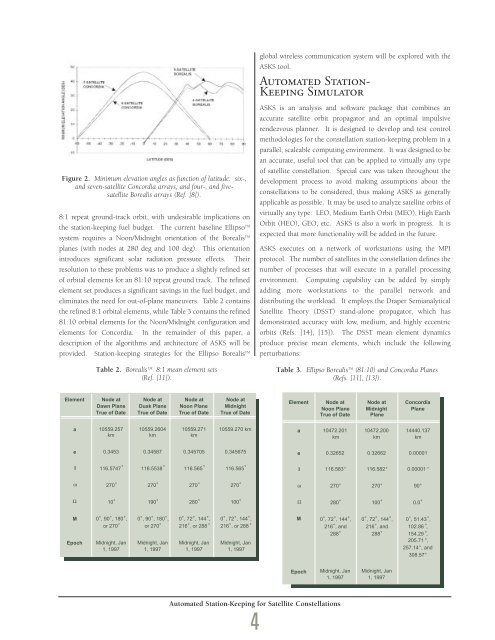1998 - Draper Laboratory
1998 - Draper Laboratory
1998 - Draper Laboratory
- No tags were found...
Create successful ePaper yourself
Turn your PDF publications into a flip-book with our unique Google optimized e-Paper software.
Figure 2. Minimum elevation angles as function of latitude: six-,and seven-satellite Concordia arrays, and four-, and fivesatelliteBorealis arrays (Ref. [8]).8:1 repeat ground-track orbit, with undesirable implications onthe station-keeping fuel budget. The current baseline Ellipso TMsystem requires a Noon/Midnight orientation of the Borealis TMplanes (with nodes at 280 deg and 100 deg). This orientationintroduces significant solar radiation pressure effects. Theirresolution to these problems was to produce a slightly refined setof orbital elements for an 81:10 repeat ground track. The refinedelement set produces a significant savings in the fuel budget, andeliminates the need for out-of-plane maneuvers. Table 2 containsthe refined 8:1 orbital elements, while Table 3 contains the refined81:10 orbital elements for the Noon/Midnight configuration andelements for Concordia. In the remainder of this paper, adescription of the algorithms and architecture of ASKS will beprovided. Station-keeping strategies for the Ellipso Borealis TMTable 2. Borealis TM 8:1 mean element sets(Ref. [11]).global wireless communication system will be explored with theASKS tool.Automated Station-Keeping SimulatorASKS is an analysis and software package that combines anaccurate satellite orbit propagator and an optimal impulsiverendezvous planner. It is designed to develop and test controlmethodologies for the constellation station-keeping problem in aparallel, scaleable computing environment. It was designed to bean accurate, useful tool that can be applied to virtually any typeof satellite constellation. Special care was taken throughout thedevelopment process to avoid making assumptions about theconstellations to be considered, thus making ASKS as generallyapplicable as possible. It may be used to analyze satellite orbits ofvirtually any type: LEO, Medium Earth Orbit (MEO), High EarthOrbit (HEO), GEO, etc. ASKS is also a work in progress. It isexpected that more functionality will be added in the future.ASKS executes on a network of workstations using the MPIprotocol. The number of satellites in the constellation defines thenumber of processes that will execute in a parallel processingenvironment. Computing capability can be added by simplyadding more workstations to the parallel network anddistributing the workload. It employs the <strong>Draper</strong> SemianalyticalSatellite Theory (DSST) stand-alone propagator, which hasdemonstrated accuracy with low, medium, and highly eccentricorbits (Refs. [14], [15]). The DSST mean element dynamicsproduce precise mean elements, which include the followingperturbations:Table 3. Ellipso Borealis TM (81:10) and Concordia Planes(Refs. [11], [13]).ElementNode atNoon PlaneTrue of DateNode atMidnightPlaneConcordiaPlanea 10472.201km10472.200km14440.137kme 0.32652 0.32662 0.00001II 116.583¡ 116.582¡ 0.00001 ¡ωω 270¡ 270¡ 90¡ΩΩ 280¡ 100¡ 0.0¡M 0¡, 72¡, 144¡,216¡, and288¡0¡, 72¡, 144¡,216¡, and288¡0¡, 51.43¡,102.86 ¡,154.29 ¡,205.71 ¡,257.14¡, and308.57¡EpochMidnight, Jan1, 1997Midnight, Jan1, 1997Automated Station-Keeping for Satellite Constellations4
















